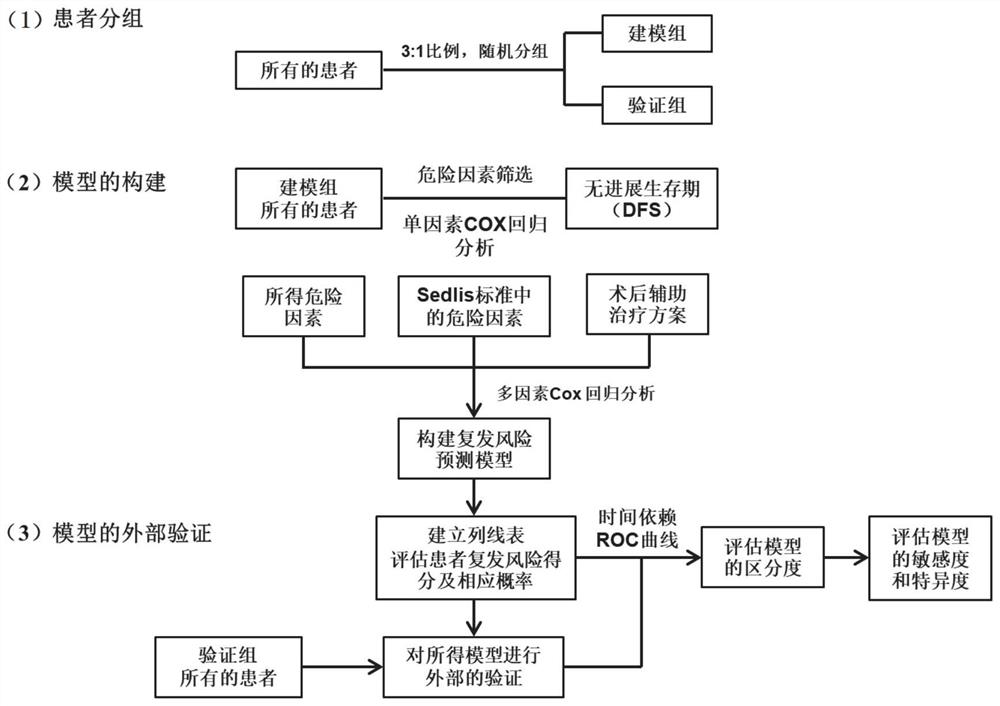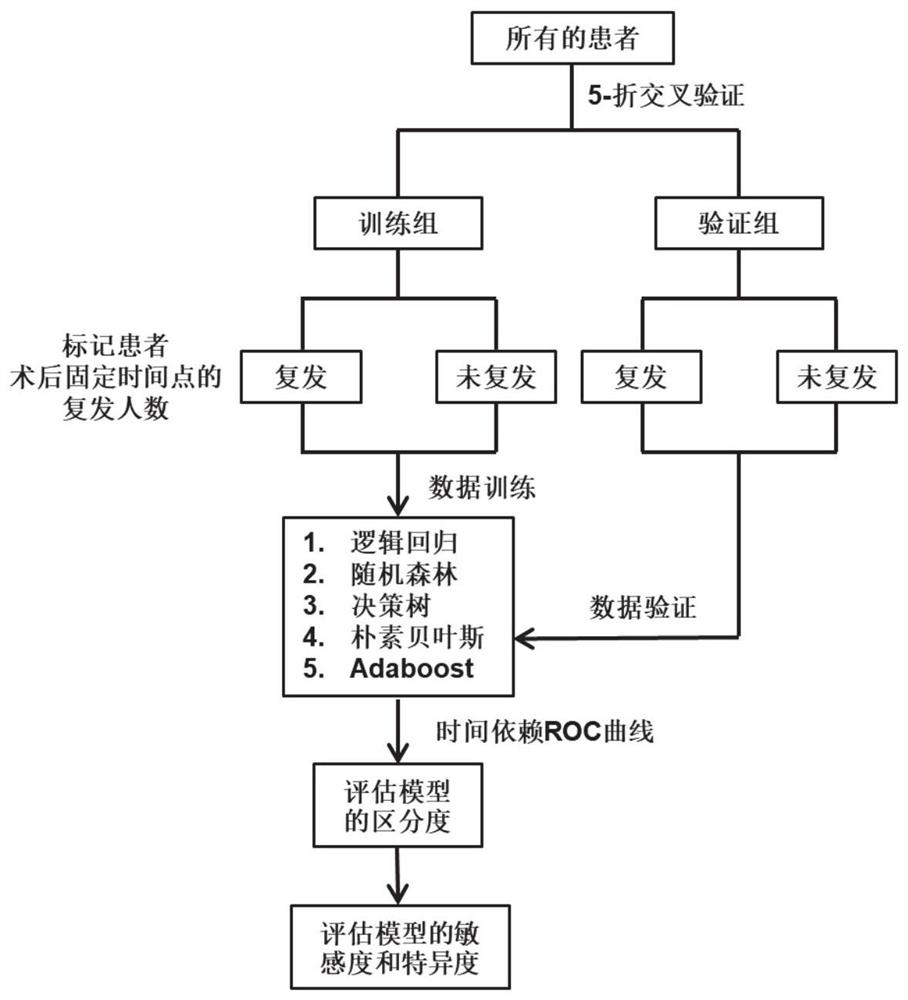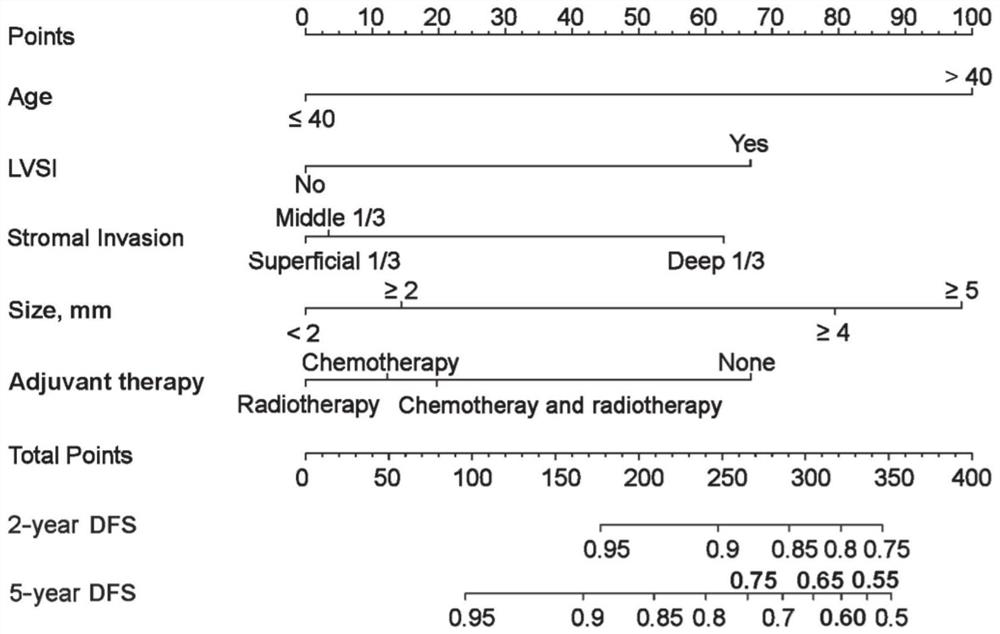Cervical cancer postoperative recurrence risk prediction method and system
A technology for risk prediction and cervical cancer, applied in the medical field, to achieve the effect of rigorous screening of high-risk factors, precise scope of application, and improved accuracy
- Summary
- Abstract
- Description
- Claims
- Application Information
AI Technical Summary
Problems solved by technology
Method used
Image
Examples
Embodiment 1
[0076] 1. Cervical cancer patients identified as stage IA2-IIA2 according to the 2009 FIGO staging system;
[0077] 2. No neoadjuvant chemotherapy or radiotherapy before operation;
[0078] 3. The surgical method is modified or radical hysterectomy and pelvic lymph node dissection;
[0079] 4. Postoperative pathological results do not include the three pathological high-risk factors of lymph node metastasis, parametrial invasion, and positive surgical margin;
[0080] 5. Not combined with other primary malignant tumors at the same time;
[0081] 6. Postoperative follow-up time of at least 2 years.
[0082] (1) Number of patients enrolled: more than 400 cases.
[0083] (2) Patient grouping: the above-mentioned patients were randomly divided into a modeling group and a verification group in a ratio of 3:1.
[0084](3) Collection of clinical data for modeling: collect the basic clinical data of the above-mentioned patients, including: age, pregnancy and childbirth history, HP...
Embodiment 2
[0094] A postoperative recurrence risk prediction system for cervical cancer, said system comprising:
[0095] Clinical data acquisition and processing module: acquire clinical data of postoperative patients with cervical cancer and perform preprocessing;
[0096] Risk factor screening module: take the postoperative progression-free survival (DFS) of the patient as the outcome, and perform single-factor COX regression analysis on the above-mentioned processed clinical data to obtain risk factors;
[0097] Model building block: take the patient's progression-free survival (DFS) as the outcome, and combine the screened risk factors (preferably with a p value less than 0.10) with the intermediate-risk pathological factors in the Sedlis criteria and postoperative adjuvant treatment options , to construct predictive models using multivariate Cox regression analysis.
[0098] Among them, in the clinical data acquisition and processing module,
[0099] The clinical data of postoper...
Embodiment 3
[0106] An electronic device, including a memory, a processor, and computer instructions stored in the memory and run on the processor. When the computer instructions are run by the processor, each operation in the method of Embodiment 1 is completed. For brevity, here No longer.
[0107] Described electronic device can be mobile terminal and non-mobile terminal, and non-mobile terminal comprises desktop computer, and mobile terminal comprises smart phone (Smart Phone, such as Android mobile phone, IOS mobile phone etc.), smart glasses, smart watch, smart bracelet, tablet computer , laptops, personal digital assistants and other mobile Internet devices that can communicate wirelessly.
PUM
 Login to View More
Login to View More Abstract
Description
Claims
Application Information
 Login to View More
Login to View More - R&D
- Intellectual Property
- Life Sciences
- Materials
- Tech Scout
- Unparalleled Data Quality
- Higher Quality Content
- 60% Fewer Hallucinations
Browse by: Latest US Patents, China's latest patents, Technical Efficacy Thesaurus, Application Domain, Technology Topic, Popular Technical Reports.
© 2025 PatSnap. All rights reserved.Legal|Privacy policy|Modern Slavery Act Transparency Statement|Sitemap|About US| Contact US: help@patsnap.com



